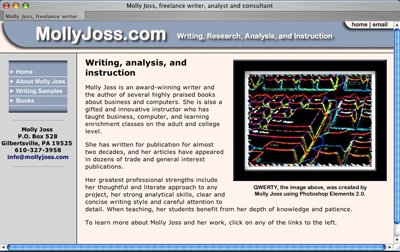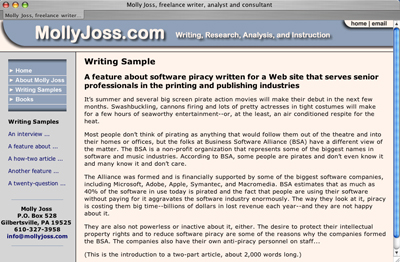Creative Fuel: Weaving a Self-Promotion Web

Creation isn’t always the tidiest process in the world. Sometimes it gets caught in the snarls of daily life or grinds to a halt completely while you earn a living. For years, that was the case with my Web site, which was supposed to be a key piece in the promotional plan for my writing and analyst business.
Long ago, I supposedly learned that just because you can do something yourself doesn’t mean that you should. Your time may be better spent doing other things — things that you enjoy more, make you more money, or don’t aggravate you as much. For example, I could change the oil in my car, but I’d rather read the paper while the dealer does it for me. I could also shingle my own roof, but that doesn’t mean I’d do the best job.
You think I would have followed this sensible line of reasoning when it came time to create my own Web site. But I didn’t, and it took me years to learn the lesson anew. My pain is your gain, however, because my experience can be like a mini-guide for you.
Ask For Help
While I had a Web site before I turned to a professional, it was limp, limited, and an embarrassment. I’m not sure what kept me from turning over the job to a Web designer sooner. Maybe I figured that because I had FrontPage and some design skills, I should do it myself. I should have remembered that a few roof shingles and some nails don’t make me a roofer.
It was shame that got me going in the end — that and a friendly face. At a conference for non-profit organizations, I talked to a nice woman who was holding fort in one of the smaller booths. A few years previously she had started a Web design firm to serve non-profits and small businesses. She showed me examples of sites she’d designed, and then she asked the right question: “What do you want your site to do for you?”
It was the right question because it made me think about the site as a business owner, not as a designer. As a designer, I was only concerned with my site’s appearance, and I didn’t have the proper skills to create the beautiful design I could envision. So, the creative process crashed. As a business owner, I knew what I wanted to make happen. Changing my role in the project changed my perspective and helped me let go. It also helped that the sites she showed me were clean, attractive, and professional, and that when we talked about fees my heart didn’t skip a beat.
Even if you’re a wiz at Web design, you can still profit from calling on experts in the areas where you’re lacking. For example, your site probably isn’t all images. If you’re not so good at words, an editor will make sure your site’s words are clear and correct.
Enough, But Not Too Much
As a business owner, I wanted a site that would let prospective clients know about me from a distance. They could find out more about me without having to come to me for the information and thus reveal themselves as potential customers. When they were ready, they could send me an e-mail or get my telephone number. It would be, in effect, a big digital billboard. Also like a billboard, it wouldn’t include everything.

Would-be clients can quickly find samples of my work and how to reach me.
I made the decision not to include the complete text of my articles. I’d seen too many examples where full text of articles posted on public sites had been lifted, borrowed — okay, let’s be frank — ripped off. I once got an e-mail from someone in China asking me a question about an article I’d written. When I asked the editor why he was selling the foreign rights without compensating me, he was flabbergasted. Turns out a daily newspaper in China found the article on the Web and reprinted it without permission. After a few letters to the Chinese publishers, the editor gave up and pulled all of the latest content from the publication’s site. So, even though I own the copyright or have reprint permission for most of my work, I opted to put limited samples on my site.

To protect my intellectual property, the site includes only small portions of my articles.
I also limit the site’s original artwork to one new image every few months. If someone wants to copy it, that’s fine with me because I didn’t put a lot of energy and time into creating it. As a visual creative pro, you don’t have that same option, but you can digitally watermark or lock images so they can’t be copied.
A Self-Promoter’s Work Is Never Done
I have several items on my site to-do list:
- Make sure the site pops up closer to the top of search engines’ results pages.
- Add my URL to the short bio and credits at the end of the articles.
- Refresh images and writing samples.
These tasks will always be on my to-do list, actually, and they should be on yours, too. Self promotion is like a good Web site — done right, it’s a project that never really ends. It’s also an important part of doing business, and it’s something you need help to do right. I’ve learned my lesson, I think. I hope.
This article was last modified on December 14, 2022
This article was first published on May 26, 2005



